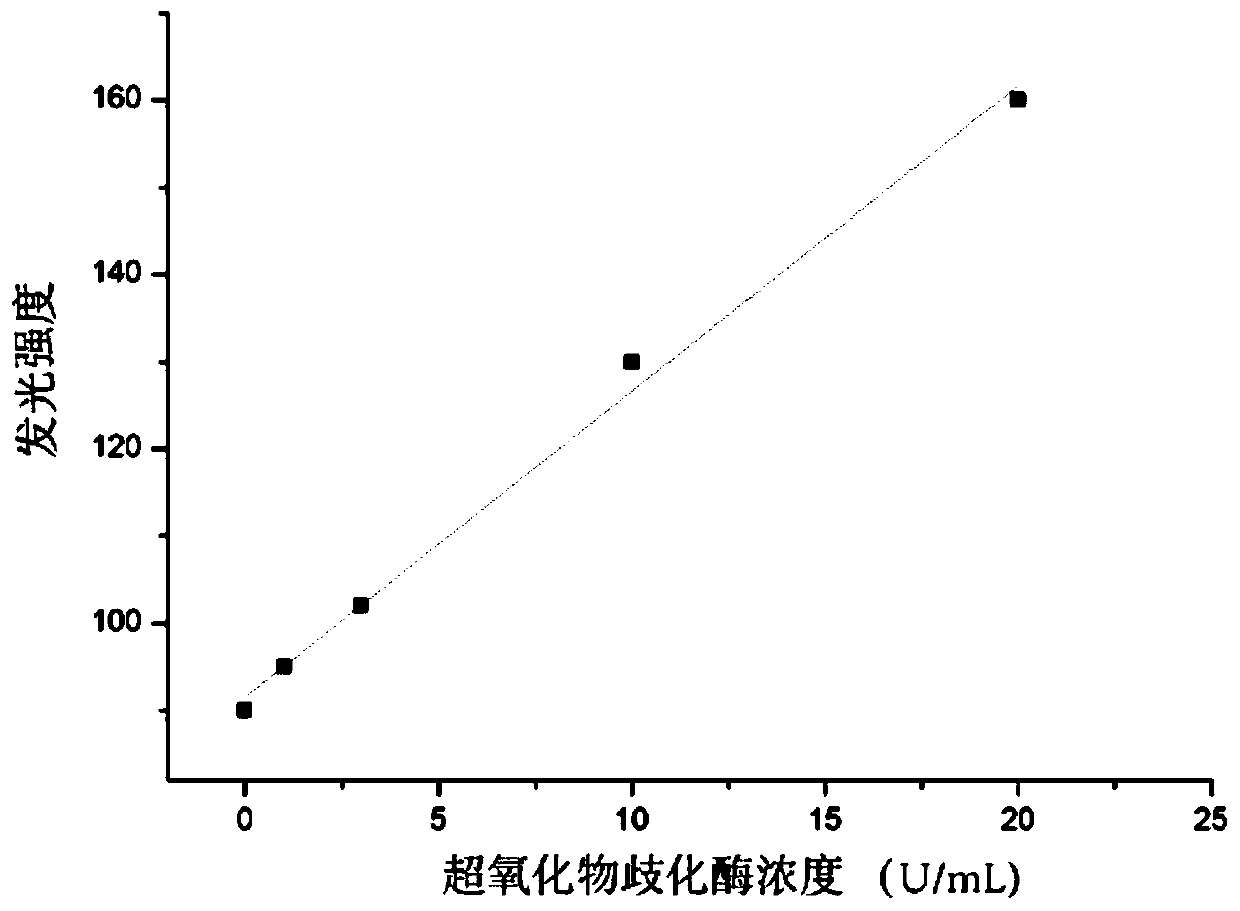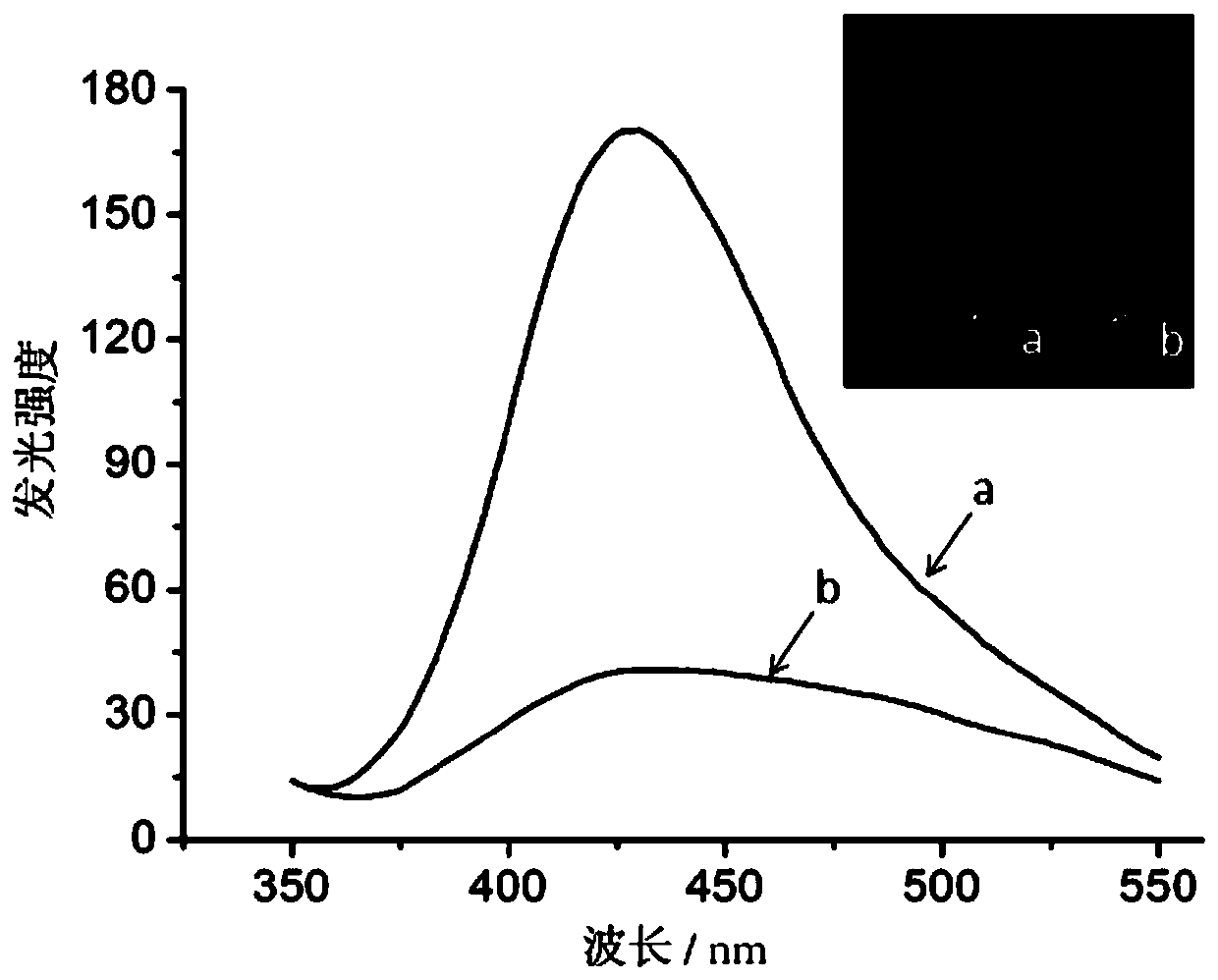Uses and kits of graphene quantum dots
A technology of graphene quantum dots and kits, applied in the field of fluorescence detection, can solve the problems of complex operation, many steps, high cost, etc., and achieve high sensitivity and strong specificity
- Summary
- Abstract
- Description
- Claims
- Application Information
AI Technical Summary
Problems solved by technology
Method used
Image
Examples
Embodiment 1
[0049] This embodiment provides a kit for detecting superoxide dismutase, which includes: graphene quantum dots and sodium hypochlorite solution.
[0050] The present embodiment also provides a detection method for superoxide dismutase, which comprises the following steps:
[0051] a. Prepare sodium hypochlorite solution (1mM) and standard solutions containing superoxide dismutase (concentrations of superoxide dismutase are 1U / mL, 3U / mL, 5U / mL, 20U / mL, respectively).
[0052] b. Mix standard solutions of different concentrations with sodium hypochlorite solution and graphene quantum dots to obtain a plurality of first mixed solutions; at the same time, uniformly mix sodium hypochlorite solution and graphene quantum dots to obtain a blank control solution.
[0053] c. Set the excitation wavelength to 365nm, respectively measure the fluorescence emission spectra of the blank control solution and multiple first mixed solutions, and measure the fluorescence intensity at the maximu...
Embodiment 2
[0057] This embodiment provides a kit for detecting superoxide dismutase, which includes: graphene quantum dots and sodium hypochlorite solution.
[0058] Wherein, the preparation method of graphene quantum dot comprises:
[0059] Take 2g of citric acid and heat it to 200°C. After 5 minutes, the citric acid liquefies; then, the color of the solution changes from colorless to light yellow, and then turns orange after 30 minutes. Stop heating.
[0060] Add the obtained orange solution dropwise to 100mL, 10mg / mL of NaOH, stir, and adjust the pH to 7 to obtain graphene quantum dots. figure 2 shown.
experiment example 1
[0062] This experimental example illustrates the use of a hypochlorite ion provided in the embodiment of the present invention in quenching the fluorescence generated by graphene quantum dots.
[0063] Sodium hypochlorite solution and graphene quantum dots were mixed evenly, as the experimental group, placed under a 365nm ultraviolet lamp for observation, and the graphene quantum dot solution was used as the control group, the results were as follows image 3 shown in the illustration.
[0064] In the control group, graphene quantum dots are yellow-green under 365nm ultraviolet light (such as image 3 shown in the middle a tube solution); and in the experimental group, the mixed solution was colorless under the 365nm ultraviolet lamp (as image 3 As shown in the b tube solution), it can be seen that hypochlorite ions have a fluorescence quenching effect on graphene quantum dots.
[0065] The excitation wavelength was set to 365nm, and the fluorescence emission spectra of the...
PUM
| Property | Measurement | Unit |
|---|---|---|
| particle diameter | aaaaa | aaaaa |
| wavelength | aaaaa | aaaaa |
Abstract
Description
Claims
Application Information
 Login to View More
Login to View More - R&D
- Intellectual Property
- Life Sciences
- Materials
- Tech Scout
- Unparalleled Data Quality
- Higher Quality Content
- 60% Fewer Hallucinations
Browse by: Latest US Patents, China's latest patents, Technical Efficacy Thesaurus, Application Domain, Technology Topic, Popular Technical Reports.
© 2025 PatSnap. All rights reserved.Legal|Privacy policy|Modern Slavery Act Transparency Statement|Sitemap|About US| Contact US: help@patsnap.com



